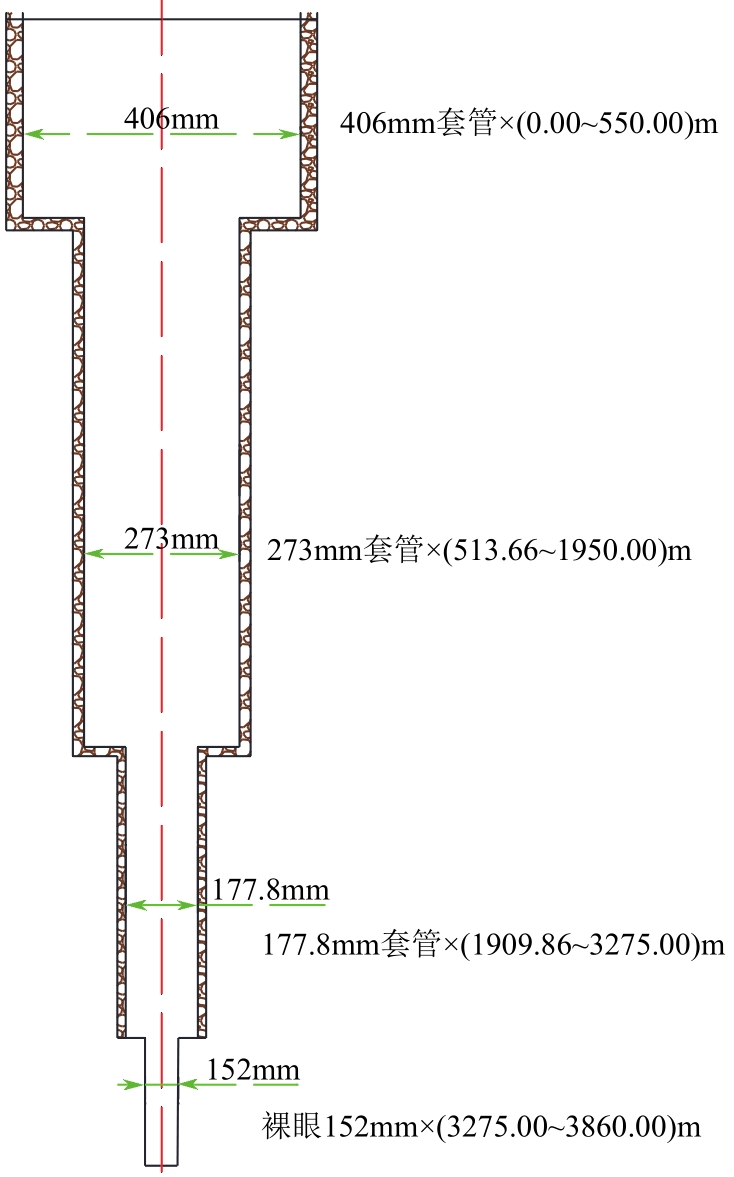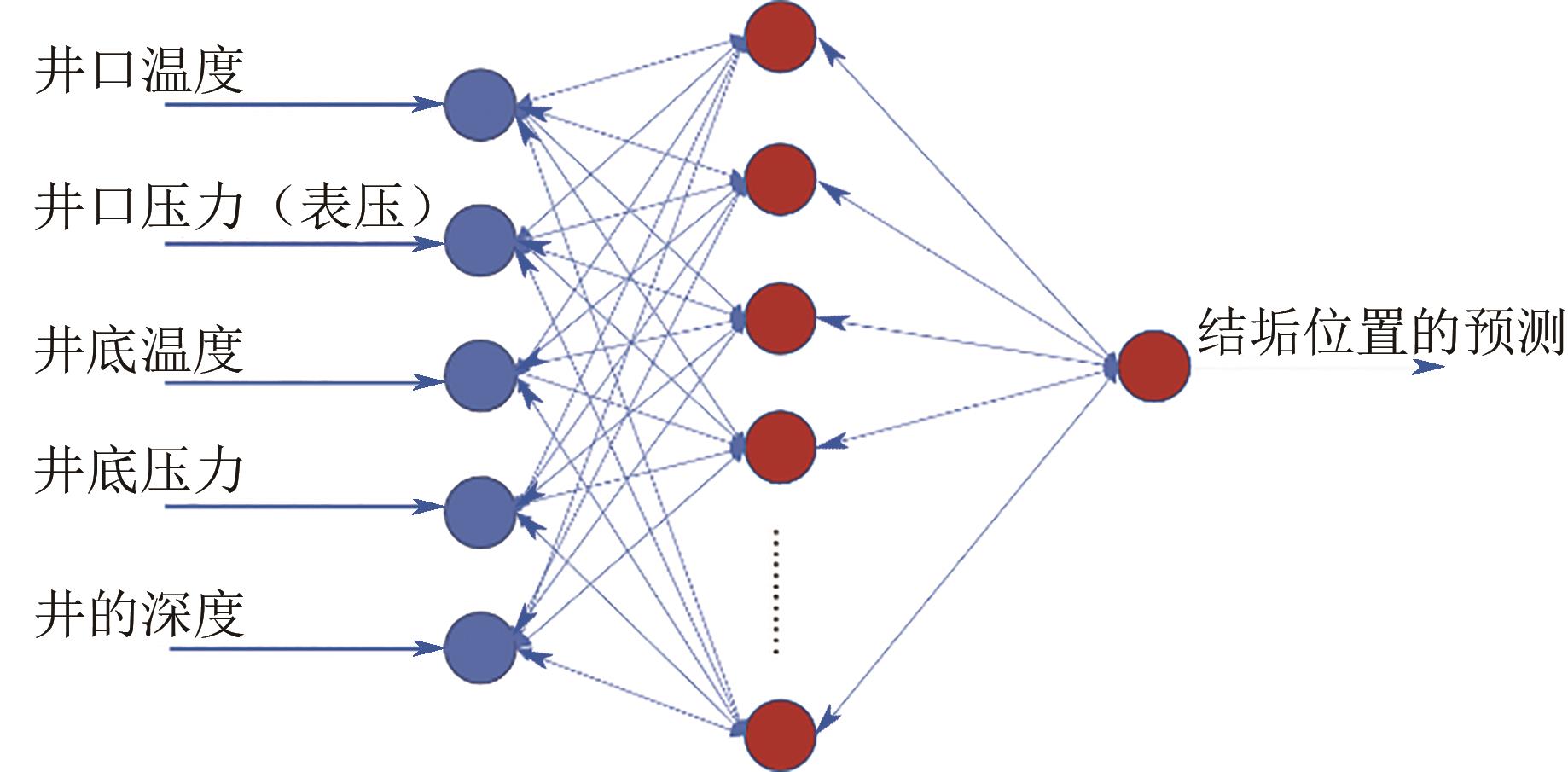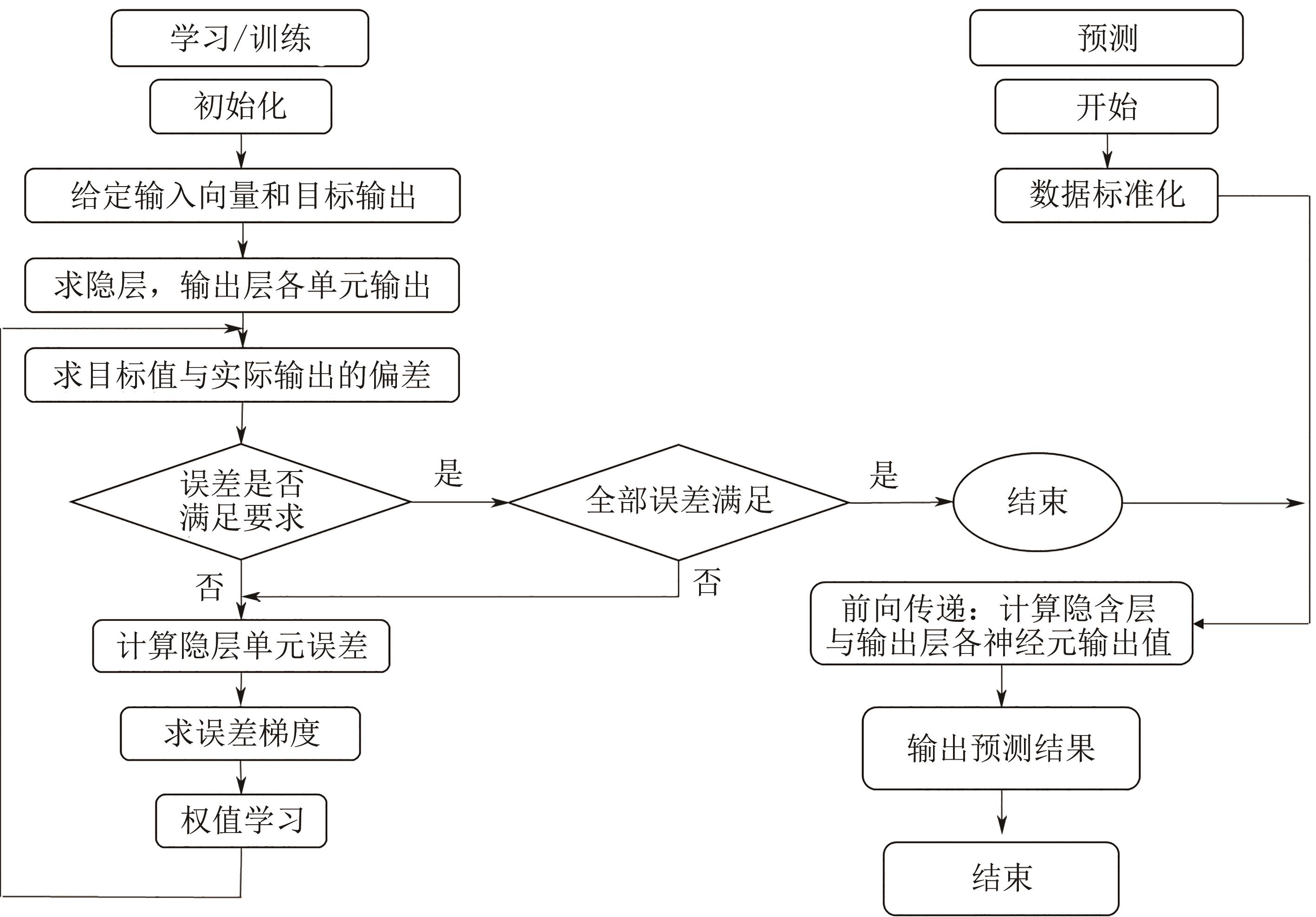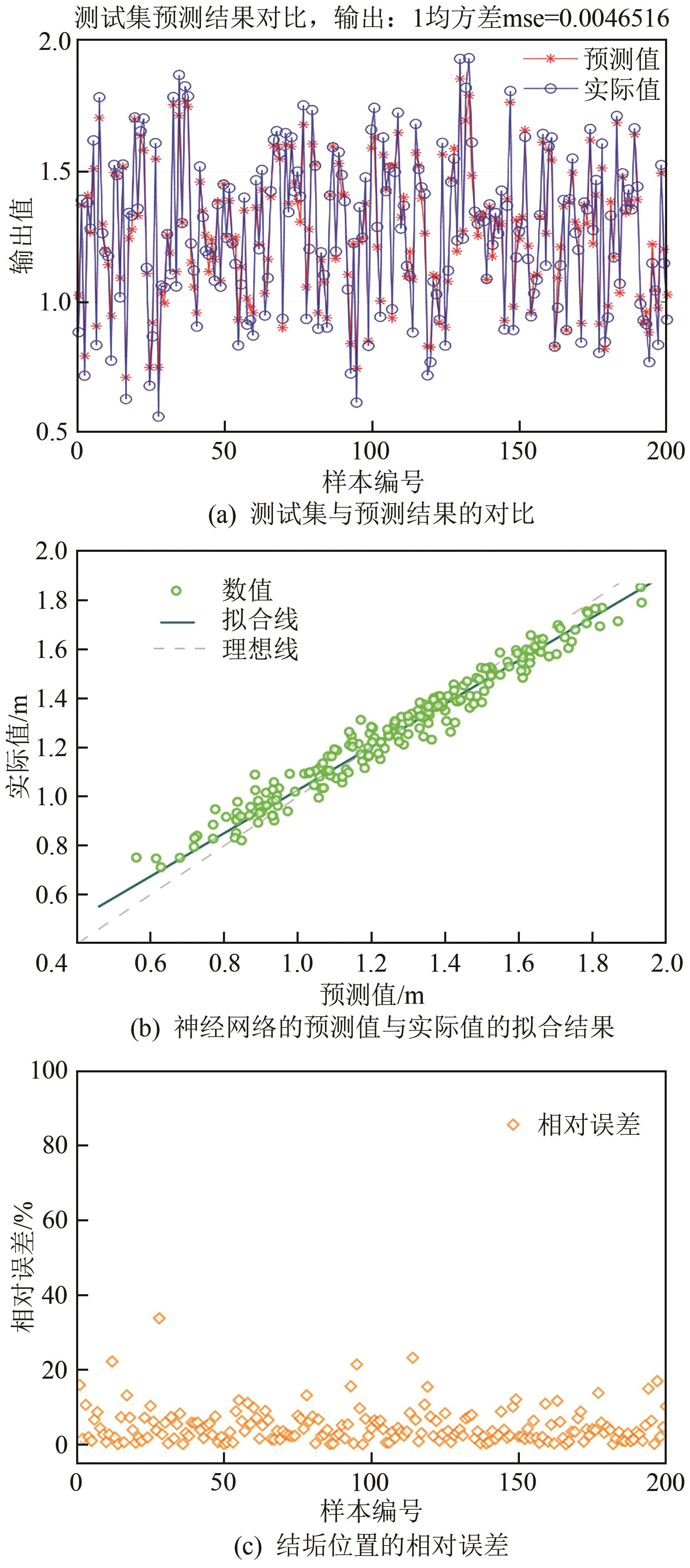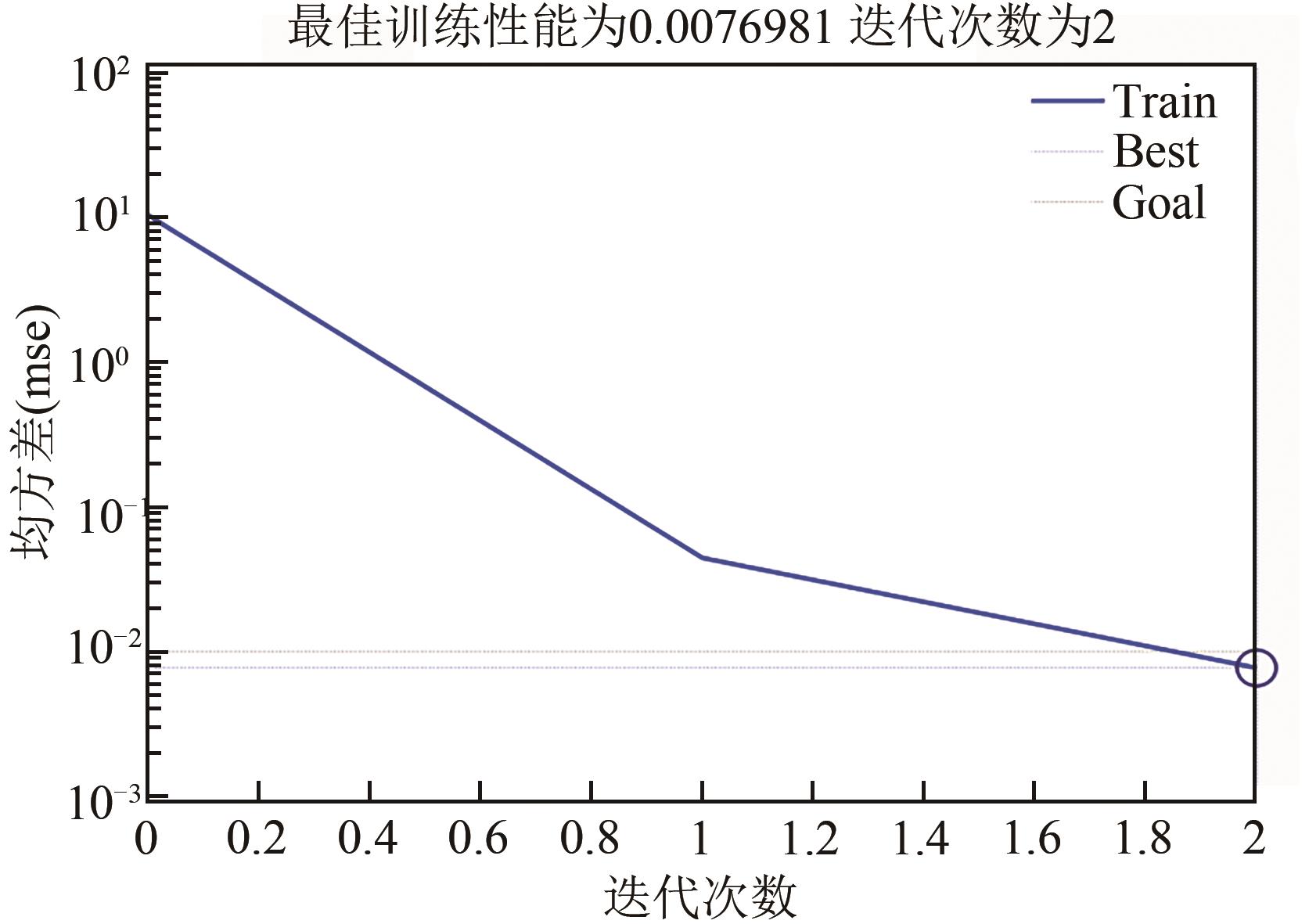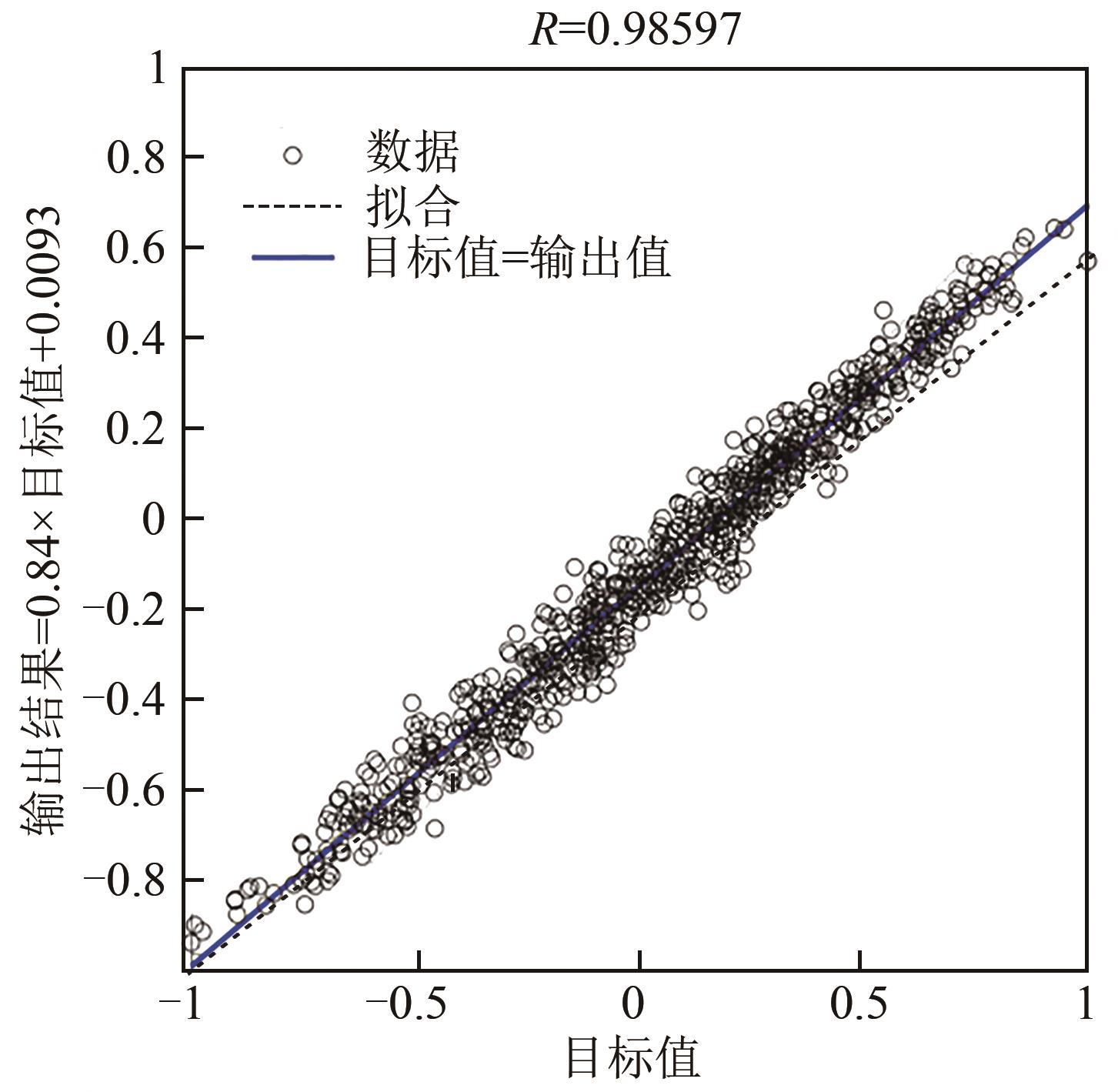化工进展 ›› 2022, Vol. 41 ›› Issue (11): 5761-5770.DOI: 10.16085/j.issn.1000-6613.2022-0216
基于BP人工神经网络预测地热井中流体的结垢位置
- 1.天津大学化工学院,天津 300350
2.化学工程联合国家重点实验室(天津大学),天津 300350
-
收稿日期:2022-02-11修回日期:2022-03-21出版日期:2022-11-25发布日期:2022-11-28 -
通讯作者:刘明言 -
作者简介:李帅(1995—),男,硕士研究生。E-mail: li568479439@163.com。 -
基金资助:国家重点研发计划(2019YFB1504104)
Prediction of scaling location of fluid in geothermal well based on BP artificial neural network
LI Shuai1( ), LIU Mingyan1,2(
), LIU Mingyan1,2( ), MA Yongli1
), MA Yongli1
- 1.School of Chemical Engineering and Technology, Tianjin University, Tianjin 300350, China
2.State Key Laboratory of Chemical Engineering (Tianjin University), Tianjin 300350, China
-
Received:2022-02-11Revised:2022-03-21Online:2022-11-25Published:2022-11-28 -
Contact:LIU Mingyan
摘要:
地热井筒中常存在因地热流体结垢而导致的生产能力下降甚至无法生产的问题,因此研究地热流体在井筒中的结垢位置等行为具有重要的应用价值。人工神经网络(ANNs)可用于开发预测地热井筒中结垢位置新模型。由于其没有机理建模的性质,故只可作为一种新的代理模型。本文以地热流体在井口和井底的温度、压力以及井深等参数作为输入变量,成功训练了三层ANNs结构,以小于10%的相对误差实现了ANNs代理模型的合适精度。对ANNs代理模型预测的结垢位置进行了分析,并与现场测量的井筒结垢位置进行了比较,分析了产生误差的原因。结果表明,新建的ANNs代理模型可作为一种实用工具,能够可靠地预测地热流体在井筒中的结垢位置。
中图分类号:
引用本文
李帅, 刘明言, 马永丽. 基于BP人工神经网络预测地热井中流体的结垢位置[J]. 化工进展, 2022, 41(11): 5761-5770.
LI Shuai, LIU Mingyan, MA Yongli. Prediction of scaling location of fluid in geothermal well based on BP artificial neural network[J]. Chemical Industry and Engineering Progress, 2022, 41(11): 5761-5770.
| 井的开度 | 井深/m | 套管直径/mm | 壁厚/mm |
|---|---|---|---|
| 一开 | 550.00 | 406.0 | 9.65 |
| 二开 | 1950.00 | 273.0 | 8.94 |
| 三开 | 3275.00 | 177.8 | 9.19 |
| 四开 | 3860.00 | 152.0 | — |
表1 地热井四开的井深结构数据
| 井的开度 | 井深/m | 套管直径/mm | 壁厚/mm |
|---|---|---|---|
| 一开 | 550.00 | 406.0 | 9.65 |
| 二开 | 1950.00 | 273.0 | 8.94 |
| 三开 | 3275.00 | 177.8 | 9.19 |
| 四开 | 3860.00 | 152.0 | — |
| 算法 | 函数 |
|---|---|
| 梯度下降法 | traingd |
| 有动量的梯度下降法 | traingdm |
| 自适应lr梯度下降法 | traingda |
| 自适应lr动量梯度下降法 | traingdx |
| 弹性梯度下降法 | trainrp |
| Fletcher-Reeves共轭梯度法 | traincgf |
| Ploak-Ribiere共轭梯度法 | traincgp |
| Powell-Beale共轭梯度法 | traincgb |
| 量化共轭梯度法 | trainscg |
| 拟牛顿算法 | trainbfg |
| 一步正割算法 | trainoss |
| Levenberg-Marquardt | trainlm |
表2 训练方法及其函数
| 算法 | 函数 |
|---|---|
| 梯度下降法 | traingd |
| 有动量的梯度下降法 | traingdm |
| 自适应lr梯度下降法 | traingda |
| 自适应lr动量梯度下降法 | traingdx |
| 弹性梯度下降法 | trainrp |
| Fletcher-Reeves共轭梯度法 | traincgf |
| Ploak-Ribiere共轭梯度法 | traincgp |
| Powell-Beale共轭梯度法 | traincgb |
| 量化共轭梯度法 | trainscg |
| 拟牛顿算法 | trainbfg |
| 一步正割算法 | trainoss |
| Levenberg-Marquardt | trainlm |
井底 温度/℃ | 井底压力/MPa | 井口 温度/℃ | 井口压力/MPa | 一开井深度/m | 二开井深度/m | 三开井深度/m | 四开井深度/m |
|---|---|---|---|---|---|---|---|
| 116 | 28 | 95 | 0.186 | 550 | 1950 | 3275 | 3860 |
| 128 | 34 | 110 | 0.180 | 450 | 2205 | 3165 | 3758 |
表3 数据库输入数据
井底 温度/℃ | 井底压力/MPa | 井口 温度/℃ | 井口压力/MPa | 一开井深度/m | 二开井深度/m | 三开井深度/m | 四开井深度/m |
|---|---|---|---|---|---|---|---|
| 116 | 28 | 95 | 0.186 | 550 | 1950 | 3275 | 3860 |
| 128 | 34 | 110 | 0.180 | 450 | 2205 | 3165 | 3758 |
| 序号 | 预测结果/m | 实际结果/m | 绝对误差 | 相对误差/% |
|---|---|---|---|---|
| 1 | 1.580 | 1.500 | 0.080 | 5.06 |
| 2 | 33.069 | 30.000 | 3.069 | 9.28 |
表4 预测结果值与实际值的对比
| 序号 | 预测结果/m | 实际结果/m | 绝对误差 | 相对误差/% |
|---|---|---|---|---|
| 1 | 1.580 | 1.500 | 0.080 | 5.06 |
| 2 | 33.069 | 30.000 | 3.069 | 9.28 |
| 1 | 《中国地热能发展报告(2018)》白皮书发布[J]. 地质装备, 2019, 20(2): 3-6. |
| China geothermal energy development report (2018) [J]. Equipment for Geotechnical Engineering, 2019, 20(2): 3-6. | |
| 2 | 蔡义汉. 地热直接利用[M]. 天津: 天津大学出版社, 2004. |
| CAI Yihan. Geothermal direct-use[M]. Tianjin: Tianjin University Press, 2004. | |
| 3 | ODDO J E, TOMSON M B. Why scale forms in the oil field and methods to predict it[J]. SPE Production & Facilities, 1994, 9(1): 47-54. |
| 4 | BOCH Ronny, LEIS Albrecht, HASLINGER Edith, et al. Scale-fragment formation impairing geothermal energy production: interacting H2S corrosion and CaCO3 crystal growth[J]. Geothermal Energy, 2017, 5(1): 1-19. |
| 5 | 刘明言. 地热流体的腐蚀与结垢控制现状[J]. 新能源进展, 2015, 3(1): 38-46. |
| LIU Mingyan. A review on controls of corrosion and scaling in geothermal fluids[J]. Advances in New and Renewable Energy, 2015, 3(1): 38-46. | |
| 6 | 刘明言, 朱家玲. 地热能利用中的防腐防垢研究进展[J]. 化工进展, 2011, 30(5): 1120-1123. |
| LIU Mingyan, ZHU Jialing. Progress of corrosion and fouling prevention in utilization of geothermal energy[J]. Chemical Industry and Engineering Progress, 2011, 30(5): 1120-1123. | |
| 7 | TOPCU Gokhan, KOÇ Gonca A, BABA Alper, et al. The injection of CO2 to hypersaline geothermal brine: a case study for Tuzla region[J]. Geothermics, 2019, 80: 86-91. |
| 8 | LEDÉSERT Béatrice A, HÉBERT Ronan L, MOUCHOT Justine, et al. Scaling in a geothermal heat exchanger at soultz-sous-forêts (upper Rhine graben, France): a XRD and SEM-EDS characterization of sulfide precipitates[J]. Geosciences, 2021, 11(7): 271. |
| 9 | 李义曼, 庞忠和. 地热系统碳酸钙垢形成原因及定量化评价[J]. 新能源进展, 2018, 6(4): 274-281. |
| LI Yiman, PANG Zhonghe. Carbonate calcium scale formation and quantitative assessment in geothermal system[J]. Advances in New and Renewable Energy, 2018, 6(4): 274-281. | |
| 10 | 蔡正敏, 李刚, 李源, 等. 肯尼亚地热电站结垢问题的日常维护[J]. 科技视界, 2018(25): 41-43. |
| CAI Zhengmin, LI Gang, LI Yuan, et al. Maintenance of geothermal power plant in Kenya[J]. Science & Technology Vision, 2018(25): 41-43. | |
| 11 | SATMAN Abdurrahman, UGUR Zuleyha, ONUR Mustafa. The effect of calcite deposition on geothermal well inflow performance[J]. Geothermics, 1999, 28(3): 425-444. |
| 12 | Gabriella STÁHL, György PÁTZAY, László WEISER, et al. Study of calcite scaling and corrosion processes in geothermal systems[J]. Geothermics, 2000, 29(1): 105-119. |
| 13 | SPINTHAKI Argyro, MATHEIS Juergen, HATER Wolfgang, et al. Antiscalant-driven inhibition and stabilization of “magnesium silicate” under geothermal stresses: the role of magnesium-phosphonate coordination chemistry[J]. Energy & Fuels, 2018, 32(11): 11749-11760. |
| 14 | Stefán ARNÓRSSON, SIGURDSSON Sven, Hördur SVAVARSSON. The chemistry of geothermal waters in Iceland. Ⅰ. Calculation of aqueous speciation from 0° to 370℃[J]. Geochimica et Cosmochimica Acta, 1982, 46(9): 1513-1532. |
| 15 | Gültekin TARCAN, Tuğbanur ÖZEN, Ünsal GEMICI, et al. Geochemical assessment of mineral scaling in Kzldere geothermal field, Turkey[J]. Environmental Earth Sciences, 2016, 75(19): 1317-1335. |
| 16 | REED M H, SPYCHER N F, PALANDRI J. Users guide for CHIM-XPT: a program for computing reaction processes in aqueous-mineral-gas systems and MINTAB guide[M]. version 2.43. Eugene, Oregon: University of Oregon, 2012. |
| 17 | Stefán ARNÓRSSON. Deposition of calcium carbonate minerals from geothermal waters—Theoretical considerations[J]. Geothermics, 1989, 18(1/2): 33-39. |
| 18 | O'SULLIVAN Michael J, PRUESS Karsten, LIPPMANN Marcelo J. State of the art of geothermal reservoir simulation[J]. Geothermics, 2001, 30(4): 395-429. |
| 19 | BÄCHLER D, KOHL T. Coupled thermal-hydraulic-chemical modelling of enhanced geothermal systems[J]. Geophysical Journal International, 2005, 161(2): 533-548. |
| 20 | RYLEY D J. The mass discharge of a geofluid from a geothermal reservoir—Well system with flashing flow in the bore[J]. Geothermics, 1980, 9(3/4): 221-235. |
| 21 | CHADHA P K, MALIN M R, PALACIO-PEREZ A. Modelling of two-phase flow inside geothermal wells[J]. Applied Mathematical Modelling, 1993, 17(5): 236-245. |
| 22 | BARELLI A, CORSI R, Del PIZZO G, et al. A two-phase flow model for geothermal wells in the presence of non-condensable gas[J]. Geothermics, 1982, 11(3): 175-191. |
| 23 | BANKOFF S G. A variable density single-fluid model for two-phase flow with particular reference to steam-water flow[J]. Journal of Heat Transfer, 1960, 82(4): 265-272. |
| 24 | PÁTZAY G, STÁHL G, KÁRMÁN F H, et al. Modeling of scale formation and corrosion from geothermal water[J]. Electrochimica Acta, 1998, 43(1/2): 137-147. |
| 25 | AKIN Taylan, Aygün GÜNEY, KARGI Hulusi. Modeling of calcite scaling and estimation of gas breakout depth in a geothermal well by using PHREEQC[C]//Fortieth Workshop on Geothermal Reservoir Engineering. Stanford University, Stanford, California, 2015:1-8. |
| 26 | HAIZLIP Jill, Aygün GÜNEY, HAKLIDIR Fusun Servin Tut, et al. The impact of high noncondensible gas concentrations on well performance Kizildere geothermal reservoir, TURKEY[C]// Thirty-Seventh Workshop on Geothermal Reservoir Engineering. Stanford University, Stanford, California 2013:1-6. |
| 27 | BJORNSSON G. A multi-feedzone geothermal wellbore simulator[R]. Office of Scientific and Technical Information (OSTI), 1987. |
| 28 | GUNN Calum, FREESTON Derek. An integrated steady-state wellbore simulation and analysis package[C]//Proceedings of the 13th New Zealand Geothermal Workshop. Auckland, NZ: New Zealand Geothermal Workshop,1991: 161-166. |
| 29 | GARG Sabodh K, PRITCHETT John W, ALEXANDER James H. A new liquid hold-up correlation for geothermal wells[J]. Geothermics, 2004, 33(6): 795-817. |
| 30 | 王龙洋, 蒙西, 乔俊飞. 基于改进集合经验模态分解和深度信念网络的出水总磷预测[J]. 化工学报, 2021(5): 2745-2753. |
| WANG Longyang, MENG Xi, QIAO Junfei. Prediction of effluent total phosphorus based on modified ensemble empirical mode decomposition and deep belief network[J]. CIESC Journal, 2021(5): 2745-2753. | |
| 31 | ZHANG Guoqiang, EDDY Patuwo B, HU Michael Y. Forecasting with artificial neural networks[J]. International Journal of Forecasting, 1998, 14(1): 35-62. |
| 32 | AYDIN Hakki, AKIN Serhat, SENTURK Erdinc. A proxy model for determining reservoir pressure and temperature for geothermal wells[J]. Geothermics, 2020, 88: 101916. |
| 33 | A Álvarez del CASTILLO, SANTOYO E, GARCÍA-VALLADARES O. Α new void fraction correlation inferred from artificial neural networks for modeling two-phase flows in geothermal wells[J]. Computers & Geosciences, 2012, 41: 25-39. |
| 34 | 赵黎丽. 两种人工智能方法应用于地热热泵系统辨识[J]. 系统仿真学报, 2004, 16(7): 1376-1379. |
| ZHAO Lili. Two artificial intelligent methods applied in the identification of geothermal heat pump system[J]. Acta Simulata Systematica Sinica, 2004, 16(7): 1376-1379. | |
| 35 | 梁海军, 郭啸峰, 高涛, 等. 河北博野某地热井结垢位置预测及影响因素分析[J]. 石油钻探技术, 2020, 48(5): 105-110. |
| LIANG Haijun, GUO Xiaofeng, GAO Tao, et al. Scaling spot prediction and analysis of influencing factors for a geothermal well in Boye County, Hebei Province[J]. Petroleum Drilling Techniques, 2020, 48(5): 105-110. | |
| 36 | BASSAM A, ORTEGA-TOLEDO D, HERNANDEZ J A, et al. Artificial neural network for the evaluation of CO2 corrosion in a pipeline steel[J]. Journal of Solid State Electrochemistry, 2009, 13(5): 773-780. |
| 37 | 张冰, 唐和礼, 黄冬梅, 等. 人工神经网络及智能算法在膜污染研究中的应用[J]. 膜科学与技术, 2021, 41(4): 160-169. |
| ZHANG Bing, TANG Heli, HUANG Dongmei, et al. Applications of artificial neural networks and intelligent algorithms in the research of membrane fouling: a critical review[J]. Membrane Science and Technology, 2021, 41(4): 160-169. | |
| 38 | 张驰, 郭媛, 黎明. 人工神经网络模型发展及应用综述[J]. 计算机工程与应用, 2021, 57(11): 57-69. |
| ZHANG Chi, GUO Yuan, LI Ming. Review of development and application of artificial neural network models[J]. Computer Engineering and Applications, 2021, 57(11): 57-69. |
| [1] | 徐晨阳, 都健, 张磊. 基于图神经网络的化学反应优劣评价[J]. 化工进展, 2023, 42(S1): 205-212. |
| [2] | 李雪佳, 李鹏, 李志霞, 晋墩尚, 郭强, 宋旭锋, 宋芃, 彭跃莲. 亲水和疏水改性膜的抗结垢和润湿能力的对比[J]. 化工进展, 2023, 42(8): 4458-4464. |
| [3] | 陈森, 殷鹏远, 杨证禄, 莫一鸣, 崔希利, 锁显, 邢华斌. 功能固体材料智能合成研究进展[J]. 化工进展, 2023, 42(7): 3340-3348. |
| [4] | 俞俊楠, 俞建峰, 程洋, 齐一搏, 化春键, 蒋毅. 基于深度学习的变宽度浓度梯度芯片性能预测[J]. 化工进展, 2023, 42(7): 3383-3393. |
| [5] | 王硕, 张亚新, 朱博韬. 基于灰色预测模型的水煤浆输送管道冲蚀磨损寿命预测[J]. 化工进展, 2023, 42(7): 3431-3442. |
| [6] | 赵景斌, 王彦富, 王涛, 马伟恺, 王琛. 基于蒙特卡洛模拟和动态事件树的储罐脆弱性评估[J]. 化工进展, 2023, 42(5): 2751-2759. |
| [7] | 贺山明, 潘界昌, 徐国钻, 李文君, 梁勇. 粗钨酸钠溶液亚铁盐沉淀法除铬、钒的热力学分析及实验验证[J]. 化工进展, 2023, 42(4): 2171-2179. |
| [8] | 张建伟, 许蕊, 张忠闯, 董鑫, 冯颖. 基于卷积神经网络的撞击流反应器浓度场混合特性[J]. 化工进展, 2023, 42(2): 658-668. |
| [9] | 王璐, 张磊, 都健. 机器学习高效筛选用于CO2/N2选择性吸附分离的沸石材料[J]. 化工进展, 2023, 42(1): 148-158. |
| [10] | 孔倩, 孙巾超, 葛佳琪, 张鹏, 马艳龙, 刘百军. 沉淀剂对NiW/TiO2-ASA催化剂加氢裂化性能的影响[J]. 化工进展, 2023, 42(1): 265-271. |
| [11] | 马云飞, 王建兵, 贾超敏, 邢懿心, 柯述, 张先. 臭氧氧化动力学模型及反应器建模研究进展[J]. 化工进展, 2022, 41(S1): 556-570. |
| [12] | 潘艳秋, 李鹏飞, 高石磊, 俞路. 基于MIC筛选规则和BP神经网络的变换装置建模及产品预测[J]. 化工进展, 2022, 41(S1): 36-43. |
| [13] | 李炜, 阮成龙, 王晓明, 李亚洁, 梁成龙. 罐式批次成品汽油调和配方集成建模方法[J]. 化工进展, 2022, 41(9): 4701-4712. |
| [14] | 冯颖, 赵孟杰, 崔倩, 解玉鞠, 张建伟, 董鑫. 分子模拟技术在壳聚糖功能材料开发和应用中的研究进展[J]. 化工进展, 2022, 41(8): 4241-4253. |
| [15] | 杨磊, 宋金玲, 唐初阳, 于诗尧, 杨欣宇. 基于FUSION模型的碳基固废热解产物产率预测[J]. 化工进展, 2022, 41(7): 3966-3973. |
| 阅读次数 | ||||||
|
全文 |
|
|||||
|
摘要 |
|
|||||
